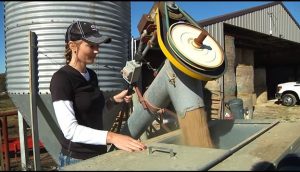
Tractors and machinery are designed to accommodate the average man. For a woman involved in agriculture, not every tractor or piece of machinery may be a safe match for you. When selecting a tractor, the first thing to look at is not the price tag but what is the right tractor size tractor for the job and is this size of tractor a safe option for the operator based on her physical attributes and capabilities.
Tractor and machinery selection, operation, and maintenance are critical to all farm operations. For new and beginning farmers, these skills may take some time to develop, and you may not have classes or workshops to attend in your area to help you. Here are some online resources to help you learn some of the basics:
Resources – Online Courses
Do you want to learn more about tractor and machinery? AgSafety4U is an online course designed for youth (ages 16 and up), new and beginning farmers, and for employers and employees of agricultural operations looking to enhance their knowledge and/or to provide professional development with a heavy emphasis on tractor and machinery. Individuals who take this course and pass the online quizzes will be able to print a certificate of completion.
Online Videos
Regional or National Articles and Resources
- Farm Tools Were Designed for Men. That’s A Problem for The Increasing Number of Female Farmers
- Pre-Operational Checks for Tractors – Penn State Extension
- National Institute for Occupational Safety and Health – Centers for Agricultural Safety and Health
- National Ag Safety Database: Tractor and Machinery
- How to Buy a Tractor? – University of Wyoming
Article Summarized and Reviewed By:
Linda Fetzer, Pennsylvania State University – lmf8@psu.edu
Karen Funkenbusch, University of Missouri – funkenbuschk@missouri.edu
Angie Hissong, OTR/L, Pennsylvania State University – anh1@psu.edu
Tevin Uthlaut, University of Missouri – UthlautT@missouri.edu
Project Funding Acknowledgement:
This material is supported by the National Institute of Food and Agriculture, U.S.D.A., under award number 2014-68006-21873.
AgrAbility for Pennsylvanians Project is supported under USDA/NIFA Special Projects 2017-41590-27105 in collaboration with Penn State Extension.
The Missouri AgrAbility Project is supported by funds from the USDA National Institute of Food and Agriculture (NIFA) under sponsored project number 2018-41590-22323.
